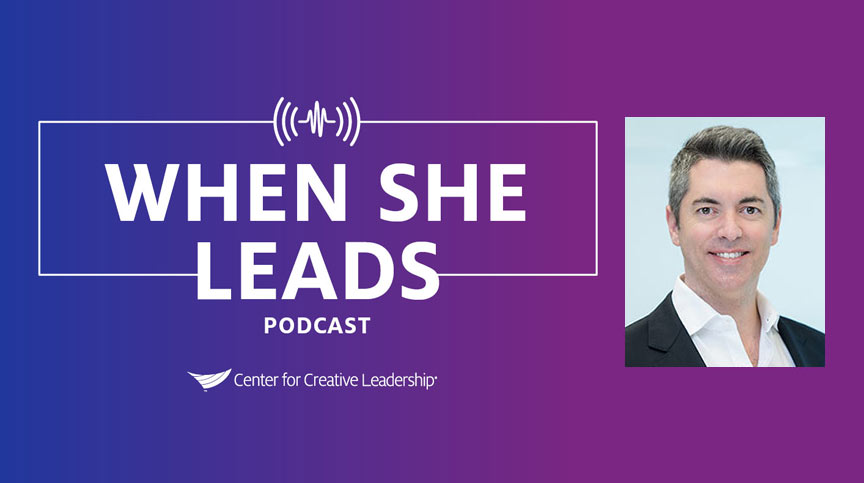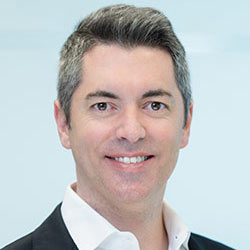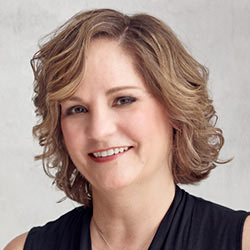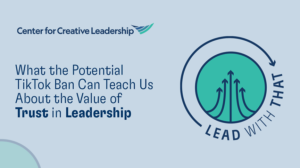- PODCAST
When She Leads: How a Manufacturing Company Stepped Up for Women in Business

In this episode of When She Leads, our women in business podcast, we speak with Hugo Martinho, who describes the challenges that the engineering, manufacturing, and construction industries have in attracting and retaining gender-diverse talent and building inclusive organizational cultures. Hugo shares with host Jennifer Martineau several steps his company has taken to increase parity. In one example, he describes how removing names from résumés helped cut back on implicit gender bias from hiring managers at the company. Listen now or read the full transcript, below.
Listen to the Podcast
In this episode of When She Leads, Hugo Martinho discusses the steps his company has taken to attract and retain gender-diverse talent. Listen now.
“It was not about discriminating against men, but it was about not letting people make decisions based on gender.”
Hugo Martinho
HR Director, Asia-Pacific
Schindler Group
Interview Transcript
INTRO:
Welcome to When She Leads, a podcast from the Center for Creative Leadership that showcases the power of women in the workplace. We’re sharing stories of inspiration and impact from executives in a range of industries and organizations around the world. These are people who are making a difference by supporting women’s advancement and development…Because we believe when she leads, it’s ultimately about better outcomes for all.
HOST, Jennifer Martineau:
This is Jennifer Martineau. I’m Senior Vice President for Research, Evaluation, and Societal Advancement at the Center for Creative Leadership. I’m honored today to be speaking with Hugo Martinho, the head of HR in Asia Pacific for Schindler.
GUEST, Hugo Martinho:
Thank you for the opportunity, Jennifer.
Jennifer:
So Hugo, tell me about your story. What is your role at Schindler? Tell me actually about Schindler and what you’re proud of in terms of what Schindler does as well.
Hugo:
Well, Schindler is a Swiss company that’s been around for 145 years in the business of elevators and escalators. My current role in Schindler is I’m in charge for HR in Asia Pacific which encompasses 12,000 employees and spreads over 16 countries.
Jennifer:
Wow, and of that what is the percentage of women that you have across the organization in Asia Pacific and at leadership levels?
Hugo:
So in Schindler overall we have roughly 11% females in our workforce of over 64,000 employees. We have a higher presence of females in leadership roles. If I take the whole leadership positions, actually we reach the 21% mark. And when we consider the top positions that country has within our 16 organizations, actually we have 4 led by women. That means 24%.
Where we definitely lack is on the technical sides. Here less than 1% of roles are taken by females. So clearly unbalanced at this level.
Jennifer:
But you’re doing some things. As we look at leadership levels across organizations usually we see that at the upper levels we have fewer, we have smaller percentages of women than at lower levels. So even despite what you’ve described in the technical space, Schindler’s doing some things to move women into leadership. What is it that you all are doing?
Hugo:
I would say that in Schindler’s DNA there is something very important, which is meritocracy. Mr. Schindler is very adamant about that. We want to have the very best, regardless of where they come from, regardless of their gender or religion or country base. Therefore that’s very clear from the very top, from the shareholders in our company.
Jennifer:
What are you doing to try to attract women into Schindler?
Hugo:
First, there’s been a tremendous effort to show that we are very technology-driven. Schindler in particular has been in the forefront of innovation.
By doing all these technological advancements, we show that this is a highly advanced technologically industry and therefore equally attractive to men and women, regardless of their physical capabilities. So we are shifting more into technology rather than it being a pure physical, hard task. That’s just one example.
Jennifer:
I imagine too, I know that in working with a number of organizations in the technical space, part of the challenge is in helping women when they’re still in school think about this kind of career.
Hugo:
The engineering industry can be equally attractive to women as it is to men. We are putting in place apprentice programs where we try to attract female engineers as a way to tweak the unbalanced situation we have today in terms of our specifically technical employee ratio.
Jennifer:
That’s fascinating. So you’ve got internship programs and other kinds of programs, apprenticeship programs, where you’re getting young women, I would assume, into the roles to get them to see what it looks like, and that it’s something that they absolutely can do and are interested in. Once you then get them into the organization, what is Schindler doing in order to grow and develop and retain and advance women in the organization?
Hugo:
It’s again part of our DNA, as I would say. We are a listed company but we proudly say that we are a family-run business. Also in the best of the Swiss tradition, we are very inclusive. So it’s in the Swiss culture, it’s in the Schindler culture about the consultative nature of making decisions and getting everybody inclusive and being part of the solutions to the problems that we encounter.
We are very strict on respect among ourselves, colleagues, of course, and with our customers. Being multinational and present all over the world, we also know that in certain countries there is a different way of handling these topics. But while we respect the different countries where we operate, our culture is one where everybody should be treated the same, and the respect should prevail at all terms.
The basic principles of working together are assessed in committees we establish. We are clearly giving very strong signs that we treat everybody equally and with respect, and it’s in our nature to have this gender equality, and everybody will be treated the same.
Jennifer:
Hugo, when you and I interacted the first time, when I was sharing some research from CCL and the book Kick Some Glass with women at Schindler, it struck me how passionate you were, and I can hear it now, how passionate you are about advancing women at Schindler. Is there a story about how you got involved? Something that got you involved and interested in women’s leadership?
Hugo:
Well thank you Jennifer … I have to say, I’m absolutely passionate and obsessed, I would even say, to be surrounded by the very best. Be surrounded by bright, intelligent, hard-working, grounded, common sense people. When you are looking for the very best, you have to look for the whole pie. You cannot just take the best out of half of the pie, right? Otherwise you are missing immediately 50% out of them.
So that’s my obsession, which ties very much with Schindler culture about meritocracy. When you’re looking for the best of the best, you need to look all around. Men, women, from different age groups, from different origins in terms of countries. So it’s this variety that enriches a culture and a company. That’s my obsession.
For me, on that note, was absolutely not acceptable that I would be managing a company where 80% or 90% in Asia Pacific would just be male. So, something was not being done right that would allow us to get to the other half of the population, to increase the quality of the people that we had. So that was my motivation, again. Being surrounded by the very best, without neglecting any target population. So that was my drive.
When we were looking to our sales force, we were seeing that it was totally male dominant. When statistics show that women with their emotional intelligence actually can even bring better results than men in most cases, and therefore once again here we saw an opportunity to leverage on this and change the ratios that we had in the company.
Jennifer:
How did you go about shifting the ratios in the sales part of the organization? What did that look like and how do you work to shift the ratio while still helping the men feel like they’re valued parts of the organization?
Hugo:
Well, there are 2 parts to it. Tweaking the rules in terms of hiring and selection, because basically what was happening is that we were dominated by men, so men would end up hiring other men. That’s usually how things work.
Jennifer:
We hire people in our own image.
Hugo:
Absolutely.
Jennifer:
Right.
Hugo:
So here we had to tweak a bit the rules and we started using blind CV’s. We were looking for the people that we found that still on a CV basis would bring the best to what we were looking for, but we would just immediately disregard the gender, and we were giving line managers who ultimately make the decisions CVs, without letting them know what gender there was.
In many cases, to their surprise at the time, they would end up short-listing 3 CVs, and all of them females. So it was not about discriminating against men, but it was about not letting people make decisions based on their gender. So that was just an example of how we started tweaking the rules. At the same time, we continue to groom and recognize our best performers, regardless if they are men or women. In that case, in the past they were all men. So we continue to recognize them and develop them, and continue with their development, but as the company was growing we felt that it was important that building for the future we needed to make this more balanced and therefore bring more women.
And considering women also for positions that in the past they were not even considered. The door was not even open for them. So we also developed and deployed sessions of clarification, sessions throughout the company where we could show, by working hand-in-hand with universities, that today many universities, their best engineering students are women.
We were also giving the examples of NASA, allegedly the most advanced engineering organization on earth, where their top project directors are equally women. So it’s about slowly with facts showing people that there’s a different way of doing things.
Jennifer:
Did you find that there’s also a certain amount of culture change that you were undergoing as you were making these shifts?
Hugo:
Yes, definitely the culture starts changing, in particular the way people relate. There are several anecdotes of when women start being more present in the office, men start moderating their language. And also we saw that with customers. So I think the relationship became much less aggressive, much more fluid. There was clearly a shift in the spirit of the organization.
You start feeling as a collective that we are integrating, and that different people bring different things to the table. So people start feeling comfortable about that and happy about that, and they start taking part of this change. It’s not someone else’s. It’s also them feeling pleased with the way things are progressing. So it’s not about making revolutions, but integrating and creating the conditions to have a natural evolution within the company.
Jennifer:
In terms of that, I’m thinking about if I’m a woman working for Schindler and I feel like I’ve been given equal opportunity as I’ve been hired, and I’ve got equal opportunities to develop and to challenge myself and so forth, what are some of the ways that I might feel that Schindler has empowered me? How might that feel? What might I experience?
Hugo:
Many times the biggest hurdle we were facing was with our female colleagues. In many ways they were not feeling confident enough to raise their hands for a promotion. I still remember how hard it was for me to convince what was at the time our first female general manager in Thailand. We had this amazing performer that had been climbing up the ladder within the organization, was with us so many years. Always succeeding in job after job, assignment after assignment.
So for us it was absolutely natural that she would make it to general manager position. The whole conversation with her was about, “But I’m still not ready for this, I’m still not ready for that.”
So basically what we have been trying to do is to mentorship, and through sponsorship, because again, it’s 2 different things, We’ve been trying to raise self-confidence, make them feel they are competent and that they will very likely succeed in their next assignment. That’s basically what we have been trying to do recently.
Jennifer:
Tell me what you all are doing in terms of mentorship and sponsorship and how it’s different. Some of the people listening to the podcast may not be aware of that difference and may not be aware of how to effectively implement mentorship and how to implement sponsorship. What is it that you all are doing?
Hugo:
Women, I would say more than men, are very open to feedback. So they take it very openly. They want the opportunity to be linked to someone who gives them advice throughout their careers. But, you know that for career progression you also need more than that. You need someone that takes some accountability for you, not just advising you. But someone that takes a stand for you.
This example of this general manager that I was referring to, that’s a good example. Our CEO at the time for the organization took on himself the responsibility to expose this person. That’s a different thing. One thing is to advise, another thing is to make yourself accountable that you’ll be opening doors, you will take a strong stance on behalf of someone. In this case this female general manager.
That’s what we’ve been doing. Every time we were identifying a talented female colleague, we would assign them a sponsor and someone that would be with a certain position in the organization that would take a strong stance, open doors, assign projects.
Because what we were realizing is that in most cases females would be much more humble or less confident, and therefore they would not be raising their hands, they would not be so outspoken in meetings. That was the difference between the mentorship and sponsorship, is by assigning each one of our female talents a sponsor that would guide and take a strong stance on the career progression of their respective female colleagues.
Jennifer:
If I’m a woman being someone to sponsor, how long does that relationship last generally?
Hugo:
Let’s say for good. So we are not prescriptive on when it ends, but throughout the time the relationship stays there and I think people start feeling accountable. So, if you take a stand, it’s for life. And that’s what has been proven. Creating strong bonds and relationships between the sponsor and the sponsoree, if I may say it.
Jennifer:
If you’re looking at somebody more senior in the organization, obviously you’ve got fewer of them than you do people several levels down. So, am I sponsoring more than one person at a time? What’s the general time burden on me?
Hugo:
Yeah, generally it’s 1 to 2 people, so not more than that for the sake of we prefer to have very efficient and consequent sponsorship, rather than just a title and then not doing much. So we limit it very much in terms of the time, the location, and then the effort also put on the sponsor. But the good thing about this, Jennifer, is that those who have been sponsored, later on they feel the obligation to give back to someone else.
Jennifer:
Mm-hmm (affirmative).
Hugo:
We have seen that people who have been sponsored in the past, they take it on themselves and they see the value of that, and then they take that initiative of being a sponsor to others. So the population is organically growing, which is very nice to see.
Jennifer:
It is indeed. Say you were starting fresh and somebody would say, “We need to have proof that this is going to work.” What data can you point to? For Schindler, what data are you seeing in terms of the impact, the positive impact?
Hugo:
What I would like to highlight is that by giving, by being able to show these examples of integrating different people into the organization, again not just on gender but on different areas, of nationalities, of getting this culture of openness, of integration, inclusiveness, and then link that to the meritocracy, performance management, we strongly believe that this makes us much stronger.
Again, a few representative signs, 10 out of our 12 executive management members were promoted from within.
Jennifer:
Oh, wow.
Hugo:
So this is a clear sign that when it comes to talent, we recognize them. So 10 out of the 12 have been doing their careers within the company, with only 2 coming from outside.
Again, out of this group of 12, we have 7 different nationalities represented. So it’s clearly in our DNA, this inclusiveness, this diversity. But we need to be broader. It’s not just the nationalities. We needed to enlarge it to the genders, to the religions, to make it a really true melting pot because we strongly believe that we need to all share values, but we necessarily need to bring different things to the table. It’s this melting pot that makes us much stronger.
And making all these small successes visible in the organization makes us feel proud and compelled to go even further.
Jennifer:
In addition to the general manager that you were talking about, do you have some examples of individuals of how the investment in women has affected their lives?
Hugo:
Well, the feedback that we have from these very successful women, it’s actually quite, quite impacting from their personal stories. They are so humble that they feel that on their own they would not get to where they are today, and they feel that they were able to reach a level within the organization that they probably would not have reached without this support.
So it’s not just about the success they reach on the professional level.
Jennifer:
Mm-hmm (affirmative).
Hugo:
But it’s the level of confidence and maturity that with this professional progression they have also reached in their own personal lives. We launched this online platform which is open to all females on a voluntary basis, to share their life stories and seek advice. We’ve been hearing amazing life stories coming out of this forum.
Jennifer:
I love your examples. So on the flip side, what’s been hard about really trying to shift the ratio of women at Schindler and in leadership levels? What’s hard about that shift and about creating lasting change?
Hugo:
Well, I would say there are different hurdles. The first one is still, as I mentioned in the beginning, to make ourselves attractive as a business in the first place, to have more women willing to join this industry. Internally, the hurdles that we faced were that in many cases we were accused that we were favoring women, and that we believed that was not at all the case. We were favoring talent, and we were favoring equality. But of course probably some people were not so happy about it, or they were seeing that some of their privileges were being taken out, and therefore accused us of favoritism of women.
And you know, we openly discuss. We are a very open company in terms of everything is allowed to be discussed. So we addressed that and we tried to show with our examples that it’s not a matter of favoritism, it’s a matter of merit, and giving equal opportunities to all. So that was clearly something that in many cases was brought up.
Jennifer:
Yeah, I can imagine that would be true because even if I understand in my head that we’re trying to diversify our workforce and that that’ll be good for all of us, it still might be felt as threat.
Hugo:
Right, right. The good thing is that as a well-structured organization where we have metrics for everything, at the end we make decisions on pure objective assessment of one’s performance as well as one’s potential.
Jennifer:
You talked about men being sponsors for women. Are there other roles that men are able to get involved in in terms of being instrumental in effecting change in the organization?
Hugo:
Well when we started most of the company was men, so we definitely would not have triggered this process without some part of the male population being a part of it. We found that was important, so how could get as many involved as possible as part of the solution? That entails a lot of communication. It’s really getting people’s agreement on the principle, and getting men equally involved. Seeing the benefits of diversity and as such being part of this process of widening the scope of our talent population. That was one of the ways that we found quite impacting.
We try to do it across the organization, from our chairman who clearly addresses the topic, from our executive members. For example our president in Asia Pacific. It’s part of a fixed agenda when he visits to the countries. It’s a topic on diversity and specifically on gender diversity on each country where he goes.
Jennifer:
Let’s get a little bit more of getting to know you. what gives you joy? What kinds of things do you enjoy doing outside of work?
Hugo:
Well, outside of work I’m very family-driven. Also because I spend 50% out of my time traveling, so I’m often away from home. So when I’m back home I take great joy in having meals with my family, starting even over breakfast. My daughter, she wakes very early to go to school, but for me it’s a great pleasure to wake up far ahead of when I would need to, technically, just for the sake of having that first hour of the day spent with her. That gives me plenty of joy.
Then being Portuguese, food is definitely part of my day’s joy as well. Also, being with friends. I’m a people person, so being surrounded by good-hearted, inquisitive people, it’s something that makes me feel engaged and motivated, yes.
Jennifer:
And you probably have a stack of books on well, not on your bedside table because you’re traveling half the time. Maybe it’s on your iPad. What are you reading that you’re enjoying?
Hugo:
There are 2 that I always recommend, especially in my role that I find very, very useful. The Servant by C. Hunter, which I find a very inspiring book. I think it’s wonderful storytelling about the basic principles of leadership, at least the way I see it. Leaders are there to serve others, and not to serve themselves. There is another one which is The Art of Execution. Because I’m a very action-driven person, and therefore it’s another book that I also like to recommend to those that work with me or around me. Because I think at the end, it’s not just about good intentions, but turn those good intentions into something. So, execution, I think the heart of execution is one that is something I pay a lot of attention to, and therefore I think it’s a quite inspiring book.
Jennifer:
Who do you look to for guidance?
Hugo:
Well, I’ve been extremely lucky, and again I credit Schindler for having very inspiring leaders that also sponsored me within the company, and whose example I try to emulate. It’s also my advice to the younger generations, more than choosing a job, you choose someone that you can learn from. And I’ve been particularly choosy in that regard, many times resisting the temptation of what could be a higher salary or a perceived higher rank of position, for the sake of having the privilege to work with this or that person.
Jennifer:
Hugo, thank you so much for your time today, it’s been so wonderful to get to know the work that you’re doing and that Schindler is doing a little bit better. It’s quite impressive.
Hugo:
Thank you Jennifer. Thank you yourself and CCL for the opportunity. We look forward to continuing this journey that we’ve started together, because there is still a long way for us to go and a lot to do. The job is never finished.
Jennifer:
Right, right. Thank you.
Hugo:
Thank you, Jennifer.
Guest featured in this episode of When She Leads:

With a career spanning roles in Europe, the Middle East, India and Singapore, Hugo Martinho brings valuable global insights on helping women face industry-specific and region-specific challenges. The Asia-Pacific Human Resources Director for Schindler Group, a global engineering and manufacturing company, Hugo has been committed to building programs that help propel women in technology forward.
Host of this episode of When She Leads:

Jennifer Martineau is the former Senior Vice President, research, evaluation, and societal advancement at CCL, where she was responsible for global research and evaluation initiatives and our work focused on leadership development in the social sector. She recently co-authored Kick Some Glass, a guide for motivated working women in business who want to take charge of their own success.
| Related Solutions
Sign Up for Newsletters
Don’t miss a single insight! Get our latest cutting-edge, research-based leadership content sent directly to your inbox.







